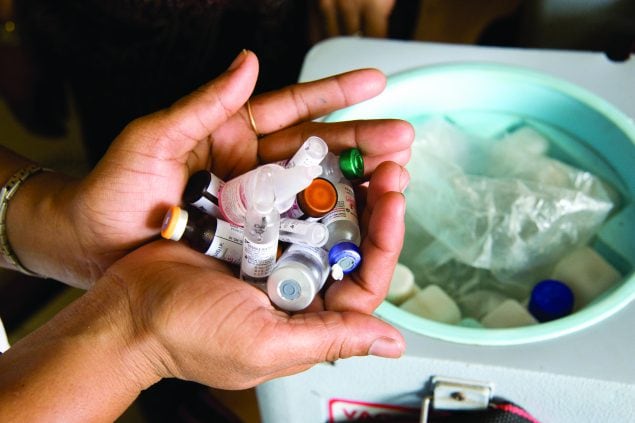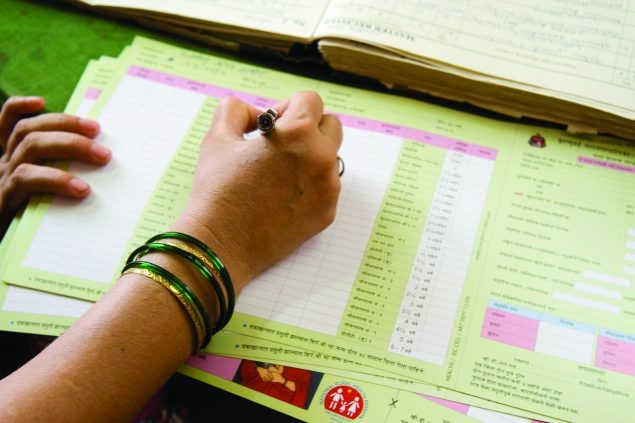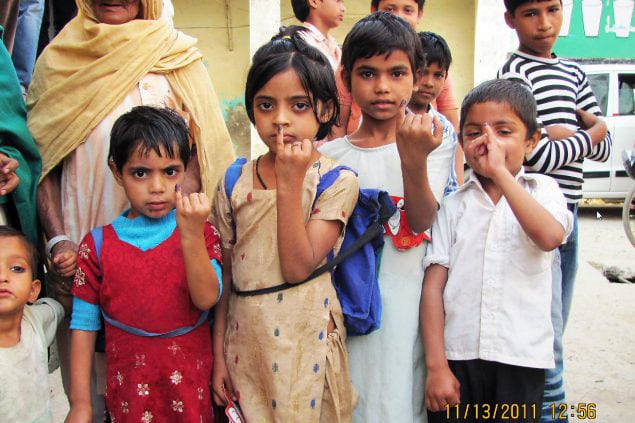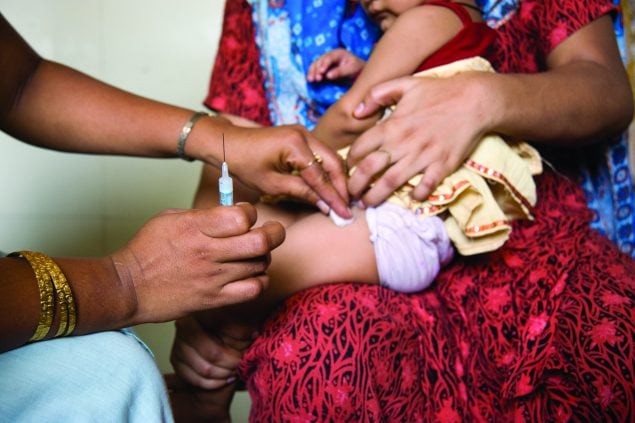Immunization

A nurse at the Lotus Colony Health Post in the Shivaji Nagar slum handles vaccines for babies coming to the center to be vaccinated. This site, in one of the largest slums in Mumbai, vaccinates about 80 kids each week, for DPT and polio primarily. © David Snyder/CDC Foundation

Auxiliary Nurse Midwife Sunanda Raut helps a fellow staff member enter the names of vaccinated youth into a log book at the Lotus Colony Health Post in the sprawling Shivaji Nagar slum in Mumbai. Sunanda has been working at the facility since 2007 and spend about half of her time out in the local community educating people on how to prevent polio and other diseases. © David Snyder/CDC Foundation
CDC and GOI collaboration on vaccine-preventable diseases began more than 50 years ago with a focus on smallpox and expanded with the Global Polio Eradication Initiative, rotavirus vaccine development, measles control, and other shared global immunization priorities. CDC efforts involved many of GOI’s leading experts and institutions, as well as multilateral partners such as the WHO and the United Nations Children’s Fund (UNICEF). CDC immunization partnerships helped establish critical public health infrastructure, much of which is already being used well beyond their original vaccine-preventable disease targets.
Smallpox Eradication
To this day, smallpox remains the only vaccine-preventable disease that has been eradicated worldwide.
More than 50 years ago, before he assumed the role of CDC director, Dr. William Foege was assigned from CDC to the South-East Asia Regional Office (SEARO) of the WHO to work on smallpox eradication throughout the Indian subcontinent. Foege worked in partnership with the Indian government and more than a quarter-million workers supporting eradication efforts across the country. India successfully eradicated smallpox in the late 1970s. To this day, smallpox remains the only vaccine-preventable disease that has been eradicated worldwide.
Polio Eradication
Polio eradication in India is a testament of GOI leadership, expertise, and collaboration with CDC and multilateral partners working together to reach the “last mile.” CDC, UNICEF, Rotary International, and WHO worked with GOI experts to design and implement the National Polio Surveillance Project, currently known as the National Public Health Support Programme (NPSP). Since its inception in 1997, NPSP was led by a series of CDC experts seconded to the WHO country office in India. CDC experts played a key role in eradicating polio in India; providing technical, programmatic, and laboratory support; and supporting the purchase of oral polio vaccine for mass vaccination campaigns. The last case of wild poliovirus was detected in India on January 13, 2011, and on March 27, 2014, WHO certified India ‘Polio Free’ along with other countries in WHO’s SEARO region.
Measles and Rubella Elimination
In 2013, the GOI committed to eliminate measles. In 2019, the country committed to eliminate rubella. India launched a campaign to introduce measles-rubella (MR) vaccine into the routine childhood immunization schedule and conducted an MR catch-up mass vaccination campaign targeting 400 million children between the ages of 9 months to 15 years old over a 3-year period. As part of this initiative, epidemiological and laboratory surveillance systems were strengthened, and measles and rubella case-based surveillance was introduced. CDC works with the Indian government, WHO, and other partners to support these efforts through technical assistance in vaccine planning, monitoring and evaluation efforts, comprehensive program reviews, and leveraging the unique capabilities and staffing of the NPSP. The incidence of measles and rubella in India reached record low levels in 2020.

Children hold up their pinkie finger marked with indelible purple ink, in order to show they have already received a polio vaccine, 2011, Photo Credit: Alan Janssen, CDC

An infant is immunized against DPT at the Lotus Colony Health Post in the Shivaji Nagar slum in Mumbai. © David Snyder/CDC Foundation
Factors that contributed to the program’s success in India, include:
- Migrant strategy development: mapping mobility patterns of migrant populations, tracking migrants, partnering with employers of migrant workers, and vaccinating migrant family members
- Vaccine optimization: coordinating field staff, and program monitoring to ensure accountability
- Strategic partnerships model: GOI provided the foundation of the program; WHO provided human resources; and CDC trained and supervised surveillance experts, with clearly defined roles for all
- Strong government commitments at the national, state, and local levels
- Relationships built on trust with the Indian government, local religious leaders, and community influencers
- Innovations and continuous adaptation to ensure success, including:
- Marking fingers of vaccinated children and clearly identifying houses of those already visited by vaccination teams
- Developing high-quality, updated, and validated micro plans
- Vaccinating migrant and hard-to-reach children by implementing the “Transit Strategy”
- Targeting efforts in high-risk areas and sub-population groups
CDC supports efforts to eradicate or control vaccine-preventable diseases in India through the Universal Immunization Program. CDC strengthens epidemiology and laboratory methods, routine immunization services, training methods, data systems, case-based disease surveillance, and outbreak preparedness and response.
CDC provides critical support to NPSP for high-priority initiatives such as Mission Indradhanush, aimed at achieving more than 90 percent immunization coverage in every district in the country. In addition, NPSP supports measles elimination and rubella elimination, Diphtheria, Pertussis & Neonatal Tetanus surveillance, new vaccine introduction, and COVID-19 response and vaccination. In July 2021, CDC again sent a senior epidemiologist to serve in the WHO’s India country office to lead NPSP.